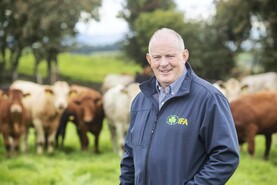The Teagasc/Irish Farmers Journal BETTER farm beef challenge’s annual study took place in Scotland last week.
Touching down in Edinburgh airport on Tuesday afternoon last, a farm tour and a visit to AgriScot agricultural show were squeezed-in before departing for home once again on Thursday afternoon.
Farm tour
Ewan Smith hosted the 26-person group of visiting farmers on his farm on Tuesday evening. Ewan farms 600ac of tillage in East Lothian, just outside Edinburgh, however, the farm also has a feedlot which finishes between 400 and 500 cattle annually.
Ewan’s system is very much in the minority in that area of Scotland.
Given the high quality of the land, much of the efforts in the area are focused on arable farming. Dairy also plays a big part.
Roughly speaking, the ratio of dairy and beef farms in the area and further south would be 50:50, much higher than the 80:20 ratio in favour of beef farming further north.

Ewan Smith.
Cattle purchased are 90% dairy-bred, typically between 12- and 18-months old, at liveweights of 300-500kg.
All stock are weighed, EID tagged and vaccinated for IBR on arrival. They are vaccinated for fluke and worms six weeks after this.
There are no slats on the farm, meaning all cattle lie on straw beds. They are cleaned every six to eight weeks.
Given the vast areas of tillage in the area, the farm is self-sufficient in straw and grain.
Furthermore, Ewan has access to bi-products of food manufacturing such as pot-ale, draft (wet distiller’s grains), vegetables and even pure potato starch. This significantly reduces feed costs on the farm.
AgriScot beef demonstration
An interactive demonstration was the stand-out beef event at AgriScot agricultural show this year. It demonstrated how a butcher selects prime cuts and how finishers can meet the butcher’s requirements. The audience could interact with questions using electronic handsets.

The markings on this animal show the variance in meat cuts on different regions of the carcase and the corresponding difference in values of each cut.
The butcher informed the audience that section A contains the most expensive meat cuts like the sirloin, fillet and rib cuts.
Next, was section C which contains the rump and round roasts.
After this is section D which contains the chuck, brisket and shank; while section B contains the least-valuable cuts with the flank and manufacturing beef originating here.

The markings on this animal show the differences in the loin and the rump of the carcase. The traditional Sunday roast comes from part D of the rump. Part A contains the sirloin and fillet, part B is the rump and part C is the top-side.
To learn more about the beef demonstration and Ewan Smith’s finishing operation, see this week’s Irish Farmers Journal in print and online and watch the video above.
The Teagasc/Irish Farmers Journal BETTER farm beef challenge’s annual study took place in Scotland last week.
Touching down in Edinburgh airport on Tuesday afternoon last, a farm tour and a visit to AgriScot agricultural show were squeezed-in before departing for home once again on Thursday afternoon.
Farm tour
Ewan Smith hosted the 26-person group of visiting farmers on his farm on Tuesday evening. Ewan farms 600ac of tillage in East Lothian, just outside Edinburgh, however, the farm also has a feedlot which finishes between 400 and 500 cattle annually.
Ewan’s system is very much in the minority in that area of Scotland.
Given the high quality of the land, much of the efforts in the area are focused on arable farming. Dairy also plays a big part.
Roughly speaking, the ratio of dairy and beef farms in the area and further south would be 50:50, much higher than the 80:20 ratio in favour of beef farming further north.

Ewan Smith.
Cattle purchased are 90% dairy-bred, typically between 12- and 18-months old, at liveweights of 300-500kg.
All stock are weighed, EID tagged and vaccinated for IBR on arrival. They are vaccinated for fluke and worms six weeks after this.
There are no slats on the farm, meaning all cattle lie on straw beds. They are cleaned every six to eight weeks.
Given the vast areas of tillage in the area, the farm is self-sufficient in straw and grain.
Furthermore, Ewan has access to bi-products of food manufacturing such as pot-ale, draft (wet distiller’s grains), vegetables and even pure potato starch. This significantly reduces feed costs on the farm.
AgriScot beef demonstration
An interactive demonstration was the stand-out beef event at AgriScot agricultural show this year. It demonstrated how a butcher selects prime cuts and how finishers can meet the butcher’s requirements. The audience could interact with questions using electronic handsets.

The markings on this animal show the variance in meat cuts on different regions of the carcase and the corresponding difference in values of each cut.
The butcher informed the audience that section A contains the most expensive meat cuts like the sirloin, fillet and rib cuts.
Next, was section C which contains the rump and round roasts.
After this is section D which contains the chuck, brisket and shank; while section B contains the least-valuable cuts with the flank and manufacturing beef originating here.

The markings on this animal show the differences in the loin and the rump of the carcase. The traditional Sunday roast comes from part D of the rump. Part A contains the sirloin and fillet, part B is the rump and part C is the top-side.
To learn more about the beef demonstration and Ewan Smith’s finishing operation, see this week’s Irish Farmers Journal in print and online and watch the video above.









 This is a subscriber-only article
This is a subscriber-only article













SHARING OPTIONS: